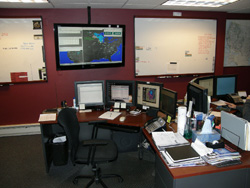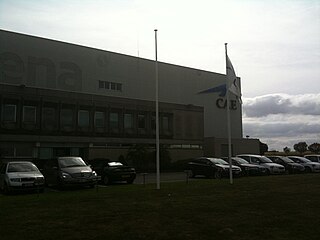
An aircraft pilot or aviator is a person who controls the flight of an aircraft by operating its directional flight controls. Some other aircrew members, such as navigators or flight engineers, are also considered aviators, because they are involved in operating the aircraft's navigation and engine systems. Other aircrew members, such as drone operators, flight attendants, mechanics and ground crew, are not classified as aviators.

Commercial aviation is the part of civil aviation that involves operating aircraft for remuneration or hire, as opposed to private aviation.

Flight training is a course of study used when learning to pilot an aircraft. The overall purpose of primary and intermediate flight training is the acquisition and honing of basic airmanship skills.
Instrument rating refers to the qualifications that a pilot must have in order to fly under instrument flight rules (IFR). It requires specific training and instruction beyond what is required for a private pilot certificate or commercial pilot certificate, including rules and procedures specific to instrument flying, additional instruction in meteorology, and more intensive training in flight solely by reference to instruments.

A private pilot licence (PPL) or, in the United States, a private pilot certificate, is a type of pilot licence that allows the holder to act as pilot in command of an aircraft privately. The licence requirements are determined by the International Civil Aviation Organisation (ICAO), but implementation varies widely from country to country. According to the ICAO, it is obtained by successfully completing a course with at least 40 hours of flight time, passing seven written exams, completing a solo cross-country flight, and successfully demonstrating flying skills to an examiner during a flight test. In the United States, pilots can be trained under Part 141 of Title 14 of the Code of Federal Regulations, which allows them to apply for their certificate after as few as 35 hours. However, most pilots require 60–70 hours of flight time to complete their training. The minimum age for a student pilot certificate is 14 for balloons and gliders and 16 for powered flight. The minimum age for a private pilot certificate is 16 for balloons and gliders, and 17 for powered flight. Pilots can begin training at any age and can solo balloons and gliders from age 14 and powered aircraft from age 16.
A commercial pilot licence (CPL) is a type of pilot licence that permits the holder to act as a pilot of an aircraft and be paid for their work.
Pilot licensing or certification refers to permits for operating aircraft. Flight crew licences are regulated by ICAO Annex 1 and issued by the civil aviation authority of each country. CAA’s have to establish that the holder has met a specific set of knowledge and experience before issuing the licence. The licence, with added ratings, allows a pilot to fly aircraft registered in the licence issuing state.

Pilot certification in the United States is typically required for an individual to act as a pilot-in-command of an aircraft. It is regulated by the Federal Aviation Administration (FAA), a branch of the U.S. Department of Transportation (USDOT). A pilot may be certified under 14 Code of Federal Regulations (CFR) Part 61 or 14 CFR Part 141. Pilots may also be certified under 14 CFR Part 107 for commercial drone operations.
Pilot licensing in the United Kingdom is regulated by the Civil Aviation Authority (CAA).

Private aviation is the part of civil aviation that does not include flying for hire, as opposed to commercial aviation.

A flight instructor is a person who teaches others to operate aircraft. Specific privileges granted to holders of a flight instructor qualification vary from country to country, but very generally, a flight instructor serves to enhance or evaluate the knowledge and skill level of an aviator in pursuit of a higher pilot's license, certificate or rating.

A flight dispatcher assists in planning flight paths, taking into account aircraft performance and loading, enroute winds, thunderstorm and turbulence forecasts, airspace restrictions, and airport conditions. Dispatchers also provide a flight following service and advise pilots if conditions change. They usually work in the operations center of the airline. In the United States and Canada, the flight dispatcher shares legal responsibility with the commander of the aircraft.

A type rating is an authorization entered on or associated with a pilot licence and forming part thereof, stating pilot's privileges or limitations pertaining to certain aircraft type. Such qualification requires additional training beyond the scope of the initial license and aircraft class training.
In the United States, there are three classes of medical certifications for pilots; such certificates are required to legally exercise the privileges of a Pilot exercising the privileges of either a Private, Commercial, or Airline Transport Pilot license. Medical Certificates are not needed for Glider, Balloon, Recreational, or Sport Pilot certifications. Each certificate must be issued by a doctor approved by the Federal Aviation Administration to a person of stable physical and mental health.

The North American Institute of Aviation (NAIA) was a private, FAA Part-141 flight school located in Conway, South Carolina, in the United States. Founded on July 7, 1972 in Hammonton, New Jersey, then later moved to South Carolina in 1978, NAIA specialized in flight and aircraft maintenance training. It has also had a campus in Las Cruces, New Mexico. The school had close connections to North European Aviation Resources (NEAR) of Vigra, Norway, and was for a period of time the ab-initio school of Scandinavian Airlines. The school subsequently commanded an excellent reputation in Northern Europe. NAIA boasted an international student population and graduates work for airlines worldwide. The school concentrated its efforts on FAA Part-141 operations and their European JAR-FCL approved program in cooperation with NEAR, which maintained a representative at the school. NAIA operated out of the Conway-Horry County Airport where it was also the fixed-base operator (FBO).

CAE Oxford Aviation Academy Brussels - Sabena Flight Academy is an aviation training organisation created in 1953, and located in Steenokkerzeel (Belgium). The school is now part of CAE Global Academy. The training is performed in Brussels, in Mesa at CAE Oxford Aviation Academy Phoenix . Sabena Flight Academy is one of the oldest airline transport pilot schools in Europe.
Multi-crew cooperation (MCC) is a training course that allows aircraft pilots to fly multi-crew aircraft. It is a requirement before a pilot may undertake a multi-crew aircraft type rating. It is also required for the issuance of an airline transport pilot license (ATPL) or a multi-crew pilot license (MPL).

A pilot logbook is a record of a pilot's flying hours. It contains every flight a pilot has flown, including flight time, number of landings, and types of instrument approaches made. Pilots also log simulator time, as it counts towards training.
Upset Prevention and Recovery Training (UPRT) is a combination of theoretical and practical training given to aircraft pilots to enable the pilot to prevent, recognise and recover from unusual attitudes and unexpected situations.
Aviation in the European Union and the European Free Trade Association is regulated by the European Union Aviation Safety Agency (EASA). EASA specifies common standards for the licensing of aircraft pilots. EASA does not issue licences, rather licences are issued by member states. However, because the same standards are used, EASA licences are recognised by all member states.










